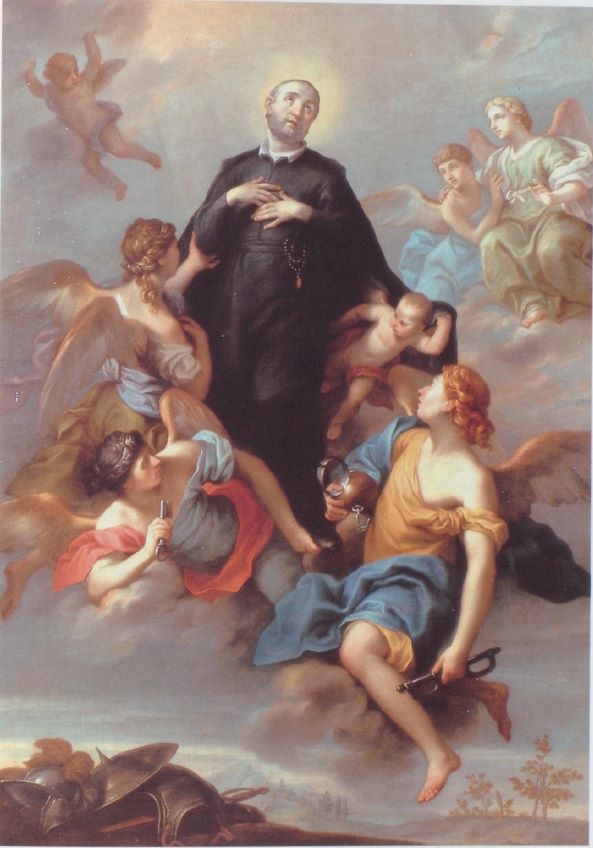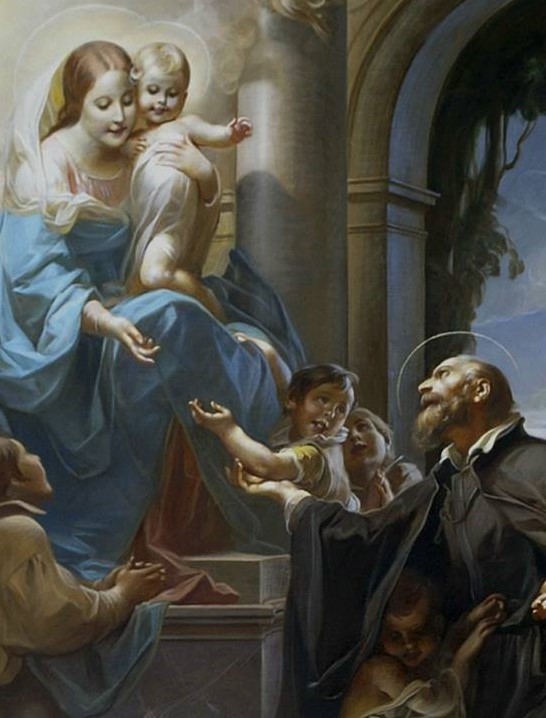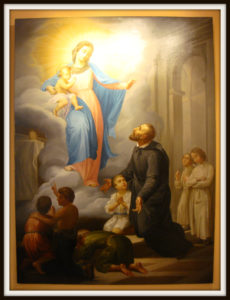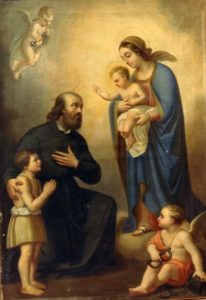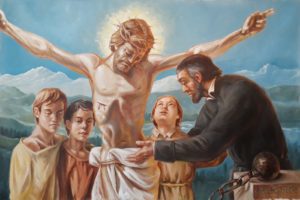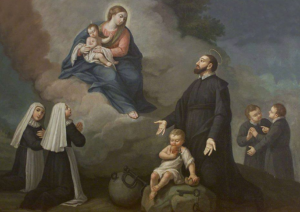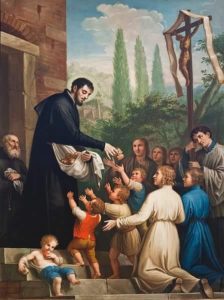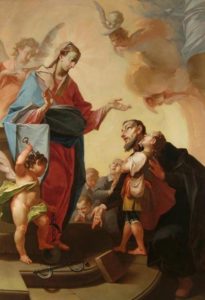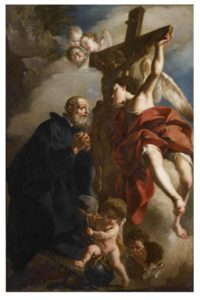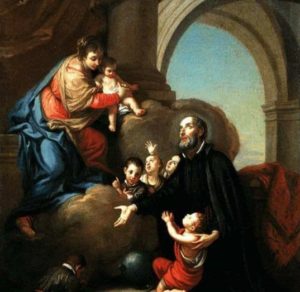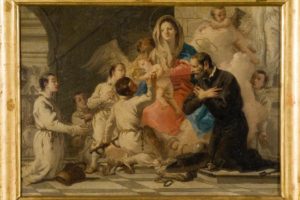Somascan Fathers and Brothers (C.R.S.)
"I will not leave you orphans; I will come to you." Jn14:18
Saint Jerome Emiliani
Founder of the Somascan Fathers and Brothers
Universal Patron Saint of the Orphans
Saint Jerome, his life
St. Jerome’s Family and His Youth St. Jerome was born in Venice in 1486, of the patrician Emiliani (Miani) family. The Mianis belonged to the Grand Council and, in their history, they could number people who had given important services to the Republic. Moreover, Jerome was related, through his mother, to the illustrious Morsosini family.
In 1496, when Jerome was ten, he tragically lost his father. As far as education is concerned, Jerome pursued a course of studies befitting his family’s social class. However, he never was a scholar but a man of action. In fact, he had the characteristics of a man of action: making friends and keeping friends easily, and being cheerful, strong minded, and enthusiastic.
At twenty-five, Jerome was involved in the events of the war against the League of Cambrai.
Jerome was entrusted the directorship of Castelnuovo of Quero. Placed on the straits on the Piave River,
In those years it had become the theater of war activity and had been lost and retaken several times. Jerome went to Castelnuovo in the early days of 1511. The most important events of his regency occurred on August 27, 1511.
Abandoned by the soldiers who were supposed to defend the castle, Jerome took the military power upon himself. But he could not resist the attacking forces. He survived with only three other men and was taken prisoner. His imprisonment lasted one month. On the morning of September 27, Jerome showed up, completely free, at the gates of Treviso. What happened the night between September 26 and 27? The prisoner had been locked in a tower. For precautionary reasons, his feet had been bound in chains. A stone ball had also been hung at his neck. In this condition, Jerome addressed the Blessed Virgin of the Madonna Grande’s shrine. With humble heart he promised to make a penitential pilgrimage if he would be saved. “A woman clothed in white” then appeared to him. She handed him the keys to open the chains and the door of the tower. Once he gained his freedom, he had to pass through the hostile army. Moreover, he did not know the way. He again beheld Mary and she led him to the sight of Treviso’s gates. Jerome kept serving the Republic until the end of the war in 1516. He was engaged in several military actions.
During these years, some family events had occurred and need to be registered. In 1514, his beloved mother died. In 1519, his brother Luke died leaving three children. The oldest was only four. Mark and especially Jerome took custody of them. In 1523, his “no-good” brother Charles got married. At the end of 1526, his brother Mark also died. Thus, on Jerome’s shoulders rested the care of all his orphaned nephews and nieces. He was forty years old and he had not produced a family of his own.
In the meantime, a deep spiritual transformation was taking place in Jerome’s soul. We cannot say exactly when this transformation occurred, but it must have been about 1525. Neither can we establish what event determined it. A very close friend of his, whose name remains unknown, gave us this information in a biography he wrote soon after Jerome’s death. He started his story with these words: “When it pleased God to move his heart and by holy inspiration draw him from worldly occupations to himself….” Listening to God’s word was the starting point. “By often listening to the word of God, he started to recall his ingratitude. He remembered his sins against the Lord. He wept often and, at the foot of the Crucified Lord, prayed to him not to be his judge, but his savior.” Under the guidance of an expert spiritual director, a regular canon of the Convent of Charity, Jerome began to associate with friends who could help him with counsel, example, and prayer. He started to go to church, listen to homilies, and attend masses regularly. In a remarkably radical decision Jerome engaged himself in the imitation of the Crucified Jesus with much self-discipline and many charitable works for the poor. He was particularly touched by the Gospel passage, “Whoever wishes to come after me must deny himself, take up his cross, and follow me.” Overwhelmed by God’s grace, he therefore “resolved to imitate his dear Master Jesus Christ with all his strength.”
What seemed like retirement from worldly events for Jerome exploded into a sweeping activity for others. In the year of his spiritual transformation, Jerome had the chance to encounter the Company of Divine Love.
Throughout Italy, a very great famine broke out in 1528. Tens and hundreds of people, sometimes-entire families, in many villages of the mainland died of starvation.
Hearing that in Venice there were more chances of finding food, crowds of poor rushed in.
Now was the time for the brothers of Divine Love to start pouring financial means and energy into the hospitals in order to relieve such misery. Among them, Jerome’s personality and activity excelled. He fed, clothed, and sheltered the poor in his house, comforted the sick, and, at night, carried to the graves the bodies abandoned by the city.
It was through the meetings with the Members of the Divine Love that a new idea of Jerome’s came to maturity. He had left a public career for charity. He had devoted his goods and energies to the poor. Why couldn’t he leave his house and family and become one of them? This idea became a firm and irrevocable decision on February 6, 1531. For the last time, let us enter with Jerome his fatherly house. There were Luke’s widow and three children: sixteen-year old John Alvise, fifteen year old Dionora, and fourteen-year old Helena. Before a notary, Jerome gave an account of how he administered the goods of his nephews and nieces. “I am fully conscious of having administered such goods with honesty and uprightness, as though they were mine.” He made a deed of gift of the other real estate, removed his patrician clothing, donned the habit of the poor, and left his house never to return again. Jerome opened a craft shop at St. Rocco, where he started the first family of orphans. In this way, he separated them from the other poor, sick, and beggars, and gave them a home.
Many people volunteered to help him. It seems that he established some schools of Divine Love in the city.
In order to understand why Jerome succeeded so rapidly, we must also report that there was a rumor that he performed miracles. Here is one of them, as told by a witness, John Paul from Seriate, a child Jerome sheltered in Bergamo. “I was there only a short time. One morning, we were twenty-eight at St. Magdalene Hospital and we were praying. Since we had nothing to eat, father Jerome told us, ‘Do not doubt, my sons, the Lord will take care!’ And while he was still praying, we heard the doorbell ring. They went to open the door. A person wanted to see father Jerome. He went to the door and came back with four loaves of bread and repeated not to doubt because the Lord would not abandon us. When the prayer was over, we went downstairs to eat. So, he fed all twenty-eight of us with only those four loaves and fresh water because he did not have anything else. And everybody had enough. And the father kept saying we had to eat cheerfully because the Lord would never abandon us.”
They decided to select a place that would be the heart of all the organization, a haven of tranquil solitude for those men who were launched on the world’s roads in incessant activity. They chose Somasca, a tiny village on the border between the Republic of Venice and the Duchy of Milan. Politically, it was Venetian, but spiritually, it was Milanese. Jerome moved to Somasca and settled there. In Somasca, the Company of the Servants of the Poor had come into being, which gathered those who intended to give up everything for the service of the poor. Later on, it became the Order of the Somascan Fathers.
In Somasca too the main concern of Jerome was the orphans. He sheltered, cured, and taught them. He fed them with the bread he received from begging. Nevertheless, they learned to live on their own work. For this reason, he introduced them to different activities.
In Somasca he established a “Spiritual Congregation” at which a great number of men convened from all over the valley on Sundays. He also developed a strong structure for teaching catechism. All this work was accompanied and supported by long hours of prayer. With some reeds Jerome had enclosed a “grotto” under a mountain buttress and created a hermitage, where he used to retire to pray before a wooden cross.
Everywhere, he found people who showed sympathy and interest in his plan and who were eager to cooperate. He then thought of a distribution of tasks and roles. He reserved the education task to himself and entrusted the economic and administrative task to these willing friends. They would also provide for the mainstreaming of the orphans into the city environment by protecting their interests and guaranteeing their success. These people also joined in associations, which were called “Companies of the Orphans.” Like a spontaneous growth, Jerome’s enterprise came to take the shape of a well-structured organization: the orphans, who were the heart, the Company of the Servants of the Poor, and then the deputies of the Companies of the Orphans. Jerome’s aim was to bring man to God.
As eight years before, he contracted the plague. On February 4, 1537, he was lodged in a small room of one of his friends, on a bed that did not even belong to him. Before lying down, he drew a cross on the opposite wall. Four days later, during the night between February 7 and 8, he died.
Saints never die. Their lives remain as models for all Christians. The Church proclaimed Jerome Blessed in 1747 and Saint in 1767. Pius XI declared him the Universal Patron Saint of the Orphans and Needy Youth. Jerome’s mission of love continuously renews itself through his sons, the Somascan Fathers and Brothers.

